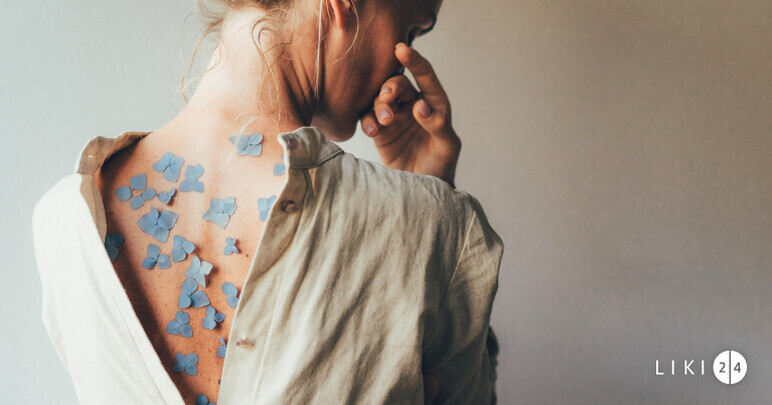Rosacea ist eine chronisch entzündliche Hauterkrankung, die nicht ansteckend ist. Sie äußert sich durch anhaltende Rötungen, Pusteln, Knötchen und andere Ausschläge auf der Gesichtshaut. Rosacea betrifft am häufigsten hellhäutige Menschen in skandinavischen Ländern.
Datumsdermatose verursacht sichtbare kosmetische Defekte, psychische Probleme und wirkt sich negativ auf die Leistungsfähigkeit und das Privatleben der Patienten aus. Frauen über 30 Jahre sind am anfälligsten für die Krankheit.
Rosacea Ursachen
Die Krankheit ist von Natur aus komplex und nicht vollständig verstanden. Die Faktoren, die die Entwicklung der Rosazea beeinflussen, werden unterteilt in:
- intern - genetische Veranlagung, vaskuläre Pathologien, endokrine Störungen, Menopause, Magen-Darm-Erkrankungen;
- extern - Kaffee, Alkohol, Zitrusfrüchte und Gewürze, heiße Speisen und Getränke, kalte oder heiße Luft, Demodex-Milben, Helicobacter pylori-Bakterien, ultraviolette Strahlung (Sonne, Sonne).
Belastende Faktoren lösen nicht bei allen Menschen Krankheiten aus, sondern nur bei denen, die dafür prädisponiert sind.
Es ist wichtig zu wissen, dass die Demodex-Milbe oder Helicobacter pylori nicht zu 100 % die Ursache der Krankheit ist. Nicht alle Rosacea-Patienten haben Demodex. Es gibt auch Hinweise auf das Vorhandensein von Helicobacter pylori bei den meisten Rosacea-Patienten, aber die vorhandenen Studien reichen nicht aus, um zu sagen, dass Helicobacter pylori die Ursache der Rosacea ist. Außerdem besiedelt dieses Bakterium nicht die Haut, sondern die Magenschleimhaut. Das unvollständige Verständnis der Krankheitsursachen erschwert die Angelegenheit.
Rosacea Symptome
Im Verlauf der Krankheit lassen sich 4 Stadien unterscheiden. Die Krankheit beginnt mit periodischen Rötungsschüben - einer leichten Rosazea. Sie treten unter dem Einfluss von Provokationsfaktoren auf, werden von Fieber begleitet und verschwinden innerhalb von Minuten oder Stunden. Solche Schübe treten von Zeit zu Zeit wieder auf.
Wenn die Rötung nicht abklingt, treten vaskuläre Teleangiektasien ("Sternchen") auf. Anstelle der Rötung tritt ein warmes, brennendes, manchmal juckendes Gefühl auf (Prä-Rosazea oder erythemato-telangiektatisches Stadium). Diese Form ist die häufigste. Oft wird die Dermatose in diesem Stadium als Rosazea oder Couperose bezeichnet.
Mit der Zeit erscheinen Papeln und Pusteln an der Stelle der Rötung (papulo-pustulöses Stadium der Rosazea).
Im nächsten Stadium bilden sich infolge einer Hyperplasie der Talgdrüsen und des Bindegewebes tumorartige Wucherungen an Nase, Stirn, Kinn und Ohren. Die Haut wird bläulich und sieht aus wie eine Orangenschale (faseriges Stadium).
Rosacea betrifft häufig die Augen und Augenlider (ophthalmisches Stadium). Gleichzeitig treten trockene Augen, Fremdkörpergefühl, Juckreiz, Brennen, Photophobie, Ödeme und verschwommenes Sehen auf.
Rosacea Behandlung
Trotz der Komplexität der Ursachen und Mechanismen, die an der Entstehung der Rosazea beteiligt sind, ist diese Krankheit behandelbar. Die wichtigsten Ziele der Therapie sind die Verringerung der Schwere der Symptome, das Erreichen einer Remission, die Verbesserung der Lebensqualität und die Verhinderung von Rückfällen.
Die Behandlung umfasst:
- richtige Hautpflege;
- Medikamentöse Therapie;
- Methoden der Gerätebehandlung;
- Minimierung von Auslösern (Provokateuren).
Medikamente gegen Rosacea
Zu den systemischen Mitteln gegen Rosazea gehören antibakterielle Medikamente und Retinoide.
- Antibiotika. Metronidazol wird verschrieben, um die Demodex-Milbe über einen Zeitraum von 4-6 Wochen auszurotten. Doxycyclin ist bei papulo-pustulöser Rosazea erforderlich. Niedrige Dosen haben eine entzündungshemmende Wirkung mit minimalen Nebenwirkungen, die Behandlungsdauer beträgt 6-12 Wochen. Bei Rosazea werden Antibiotika in Tablettenform eingenommen, in leichten Fällen kann jedoch eine topische antibiotische Salbe verabreicht werden. Metronidazol-Rosacea-Creme ist ein klassisches Arzneimittel zur Behandlung von Rosacea.
- Retinoide hemmen Entzündungen, reduzieren die Talgproduktion und die Größe der Talgdrüsen.
Zur lokalen Behandlung von Rosazea gehören antiseptische Lotionen (Hyseac Reinigungslotion), die die unangenehmen Symptome wie Brennen und Juckreiz lindern und die Durchblutung der Haut verringern.
Rosacea-Cremes mit 10-20% Azelainsäure (Revox- Just azelaic acid, Ceramol- Spot Block) haben sich ebenfalls als recht wirksames Mittel gegen Rosacea etabliert. Azelainsäure normalisiert die Verhornungsprozesse der Haut, hemmt die Vermehrung der Hautzellen, hat eine ausgeprägte entzündungshemmende Wirkung und reduziert die Pigmentierung.
Die Metroruboril Creme wird zur Behandlung der papulo-pustulösen Rosazea eingesetzt. Die Wirkstoffe Azelainsäure, β-Calm-Komplex reduzieren Rötungen in 4 Wochen, verbessern die Mikrozirkulation der Haut, reduzieren entzündliche Läsionen (Papulose und Pusteln), befeuchten und beruhigen die Haut.
Nach den neuesten Daten wird der α-adrenerge Agonist Oxymetazolin zur Behandlung der persistierenden Rosazea eingesetzt. Sie sind für die Anwendung bei Erwachsenen zugelassen. Topische Präparate wirken auf die Blutgefäße, wodurch die Rötung nach 30 Minuten (Brimonidintartrat) oder 60 Minuten (Oxymetazolin) verschwindet.
Kosmetische Produkte für Rosacea
Bei Rosacea ist es gefährlich, die Bedeutung der Hautpflege zu unterschätzen, sowohl während einer Exazerbation als auch während der Remission. Die Haut sollte vor UV-Strahlen geschützt, sanft gereinigt und mit Feuchtigkeit versorgt werden.
Die besten Hautpflegeprodukte für Rosacea sind solche, die für den Patienten geeignet sind und die Erkrankung nicht verschlimmern. Für die Gesichtsreinigung sollten fettfreie Lotionen mit einem neutralen pH-Wert bevorzugt werden. Es gibt ganze Linien von Dermatokosmetika für Haut mit Rosacea, wie zum Beispie lLa Roche Posay rosacea.
Rosacee naturheilkundliche Behandlung
Grüner Tee
Grüner Tee hat sich aufgrund seiner entzündungshemmenden Eigenschaften als wirksam bei der Behandlung von Rosazea erwiesen. Brühen Sie eine Tasse Tee auf und kühlen Sie ihn dann ab. Tränken Sie eine Kompresse mit dem kalten Tee und legen Sie sie auf die Problemzonen.
Hafer
Hafer hat lindernde Eigenschaften, die helfen können, gereizte Stellen zu beruhigen. Verwenden Sie ½ Tasse Haferkleie und ¼ Tasse Wasser, um eine Paste herzustellen. Tragen Sie die resultierende Paste auf die Problemzonen auf, lassen Sie sie etwa 20 Minuten einwirken und spülen Sie sie dann mit kaltem Wasser ab.
Die kleine Maus
Mosley hat entzündungshemmende Eigenschaften, die Entzündungen lindern und Rötungen im Gesicht abklingen lassen. Auch Inhaltsstoffe wie Flavonoide haben eine beruhigende Wirkung auf die Haut.
Honig
Honig ist bekannt für seine antimikrobiellen, antioxidativen und entzündungshemmenden Eigenschaften. Er ist daher hilfreich bei der Behandlung von Rosacea-Symptomen.
Massieren Sie die Haut mit natürlichem Honig und spülen Sie sie mit lauwarmem Wasser ab, nachdem Sie sie etwa 20 Minuten lang einwirken lassen.
Auch wenn Rosacea keine lebensbedrohliche Erkrankung ist, hat sie doch negative Auswirkungen auf die Lebensqualität. Obwohl die genauen Ursachen nicht bekannt sind und es keine Heilung gibt, gibt es bestimmte Lösungen, die die Symptome lindern und so die Lebensqualität der Betroffenen verbessern können. Daher wird eine Behandlung im Frühstadium empfohlen, um die Rosacea-Symptome unter Kontrolle zu halten.



 Wellness
Wellness  Fitness
Fitness  Ernährung
Ernährung  Schönheit
Schönheit  Schönheit
Schönheit  208 angesehen
208 angesehen 





 Vorheriger Artikel
Vorheriger Artikel 







